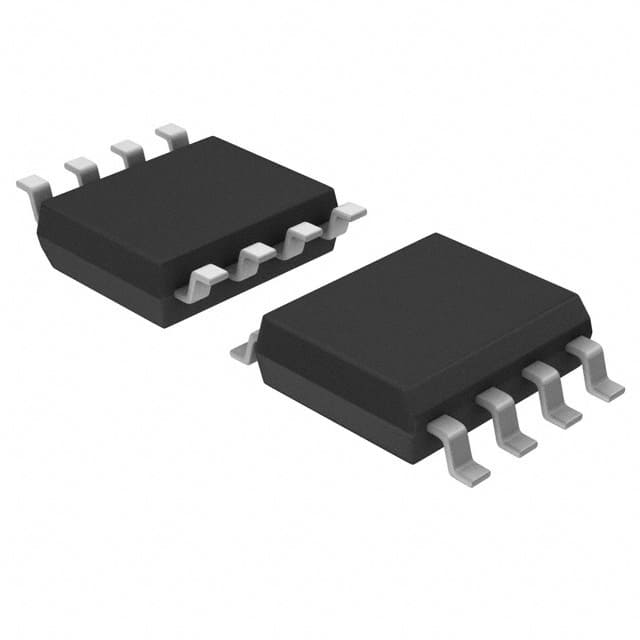Veja as especificações para detalhes do produto.

S-24CS04AFJ-TB-G
Product Overview
Category
The S-24CS04AFJ-TB-G belongs to the category of Serial EEPROM (Electrically Erasable Programmable Read-Only Memory) integrated circuits.
Use
This product is primarily used for non-volatile data storage in various electronic devices, such as microcontrollers, sensors, and communication modules.
Characteristics
- Non-volatile memory: The S-24CS04AFJ-TB-G retains stored data even when power is removed.
- High endurance: It supports a large number of read and write cycles, ensuring long-term reliability.
- Low power consumption: The device operates at low voltage levels, making it suitable for battery-powered applications.
- Small form factor: The compact package allows for easy integration into space-constrained designs.
Package
The S-24CS04AFJ-TB-G is available in a small surface-mount package, typically a Thin Small Outline Package (TSOP).
Essence
The essence of this product lies in its ability to provide reliable and non-volatile data storage in a compact and energy-efficient manner.
Packaging/Quantity
The S-24CS04AFJ-TB-G is commonly supplied in reels or tubes, with quantities varying depending on the manufacturer's specifications.
Specifications
- Memory capacity: 4 kilobits (512 bytes)
- Interface: I2C (Inter-Integrated Circuit)
- Operating voltage: 1.7V to 5.5V
- Operating temperature range: -40°C to +85°C
- Write endurance: 1 million cycles
- Data retention: 100 years
Detailed Pin Configuration
The S-24CS04AFJ-TB-G has a standard 8-pin configuration:
- VCC: Power supply voltage
- GND: Ground reference
- SDA: Serial Data Line (I2C)
- SCL: Serial Clock Line (I2C)
- WP: Write Protect (optional)
- A0: Address bit 0 (for device addressing)
- A1: Address bit 1 (for device addressing)
- NC: No Connection
Functional Features
- Random access: The S-24CS04AFJ-TB-G allows for direct read and write operations at any memory location.
- Byte-level programming: Individual bytes can be independently programmed, allowing for efficient data storage and retrieval.
- Hardware write protection: The optional Write Protect pin provides a means to protect the stored data from accidental modification.
- Software write protection: The device supports software-based write protection through specific command sequences.
Advantages and Disadvantages
Advantages
- Non-volatile memory ensures data retention even during power loss.
- High endurance allows for frequent read and write operations without compromising reliability.
- Low power consumption makes it suitable for battery-powered applications.
- Compact package enables easy integration into space-constrained designs.
Disadvantages
- Limited storage capacity compared to other memory technologies.
- Slower write speeds compared to volatile memory alternatives.
- Relatively higher cost per byte of storage.
Working Principles
The S-24CS04AFJ-TB-G utilizes an I2C interface to communicate with the host microcontroller or system. It follows the I2C protocol, which involves a master-slave relationship between the microcontroller and the EEPROM. The microcontroller initiates read or write operations by sending specific commands and addresses over the I2C bus.
During a write operation, the microcontroller sends the data to be stored along with the target memory address. The EEPROM then stores the data in the specified location. Similarly, during a read operation, the microcontroller sends the memory address it wants to access, and the EEPROM returns the corresponding data.
Detailed Application Field Plans
The S-24CS04AFJ-TB-G finds applications in various fields, including but not limited to:
- Consumer electronics: Used for storing configuration settings, user preferences, and firmware updates in devices like smartphones, tablets, and gaming consoles.
- Industrial automation: Employed for data logging, parameter storage, and device identification in industrial control systems.
- Automotive electronics: Utilized for storing critical information such as mileage, fault codes, and calibration data in automotive modules.
- Medical devices: Used for storing patient data, device settings, and calibration values in medical equipment and instruments.
- Internet of Things (IoT): Integrated into IoT devices for storing sensor data, network configurations, and firmware updates.
Detailed and Complete Alternative Models
- S-24CS02AFJ-TB-G: 2 kilobits (256 bytes) capacity, otherwise similar specifications.
- S-24CS08AFJ-TB-G: 8 kilobits (1024 bytes) capacity, otherwise similar specifications.
- S-24CS16AF
Liste 10 perguntas e respostas comuns relacionadas à aplicação de S-24CS04AFJ-TB-G em soluções técnicas
Sure! Here are 10 common questions and answers related to the application of S-24CS04AFJ-TB-G in technical solutions:
Q: What is S-24CS04AFJ-TB-G? A: S-24CS04AFJ-TB-G is a specific model of EEPROM (Electrically Erasable Programmable Read-Only Memory) chip.
Q: What is the storage capacity of S-24CS04AFJ-TB-G? A: S-24CS04AFJ-TB-G has a storage capacity of 4 kilobits, which is equivalent to 512 bytes.
Q: What are some typical applications of S-24CS04AFJ-TB-G? A: S-24CS04AFJ-TB-G is commonly used in various electronic devices such as consumer electronics, industrial equipment, automotive systems, and medical devices.
Q: How does S-24CS04AFJ-TB-G connect to a microcontroller or other devices? A: S-24CS04AFJ-TB-G uses the I2C (Inter-Integrated Circuit) protocol for communication, which requires two lines - SDA (Serial Data) and SCL (Serial Clock).
Q: Can S-24CS04AFJ-TB-G be reprogrammed multiple times? A: Yes, S-24CS04AFJ-TB-G is an EEPROM, which means it can be electrically erased and reprogrammed multiple times.
Q: What is the operating voltage range of S-24CS04AFJ-TB-G? A: S-24CS04AFJ-TB-G operates within a voltage range of 1.7V to 5.5V.
Q: Does S-24CS04AFJ-TB-G have any built-in security features? A: Yes, S-24CS04AFJ-TB-G supports write protection of individual memory blocks using a hardware write-protect pin.
Q: What is the maximum operating frequency of S-24CS04AFJ-TB-G? A: The maximum operating frequency of S-24CS04AFJ-TB-G is typically 400 kHz.
Q: Can S-24CS04AFJ-TB-G operate in extreme temperature conditions? A: Yes, S-24CS04AFJ-TB-G is designed to operate within a wide temperature range, typically from -40°C to +85°C.
Q: Are there any specific precautions to consider when using S-24CS04AFJ-TB-G? A: It is important to follow the manufacturer's guidelines for proper handling, storage, and soldering of S-24CS04AFJ-TB-G to ensure its optimal performance and reliability.
Please note that the answers provided here are general and may vary depending on the specific datasheet and application requirements of S-24CS04AFJ-TB-G.

